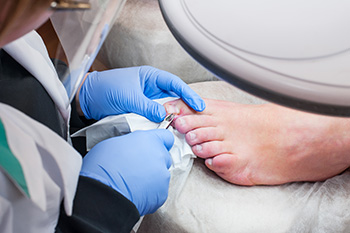
Ingrown toenails occur when the nail grows into the skin of the toe, causing irritation, inflammation, and sometimes infection. Home remedies may provide temporary relief from an ingrown toenail, but if pain persists or signs of infection develop, seeking attention from a podiatrist is important. In such cases, prescription medication and surgical intervention may be necessary. Nail avulsion is a minor procedure that involves removing the ingrown portion of the nail, or the entire nail plate, under local anesthesia. Partial nail avulsion allows for regrowth within months, while complete nail avulsion is less common and results in permanent removal. For recurrent cases of ingrown toenails, a matrixectomy may be recommended. This involves removing the nail root to prevent future ingrowth. Various techniques, including chemical, electrosurgical, or surgical methods, are employed based on individual needs. When an infection develops, a podiatrist will prescribe oral antibiotics to clear the bacteria and prevent complications. If you have persistent pain or redness due to an ingrown toenail, it is suggested that you schedule an appointment with a podiatrist for an exam and treatment options.
Ingrown toenails can become painful if they are not treated properly. For more information about ingrown toenails, contact Sarah Urton, DPM of Kitsilano Foot and Ankle Clinic. Our doctor can provide the care you need to keep you pain-free and on your feet.
Ingrown Toenails
Ingrown toenails occur when a toenail grows sideways into the bed of the nail, causing pain, swelling, and possibly infection.
Causes
- Bacterial infections
- Improper nail cutting such as cutting it too short or not straight across
- Trauma to the toe, such as stubbing, which causes the nail to grow back irregularly
- Ill-fitting shoes that bunch the toes too close together
- Genetic predisposition
Prevention
Because ingrown toenails are not something found outside of shoe-wearing cultures, going barefoot as often as possible will decrease the likeliness of developing ingrown toenails. Wearing proper fitting shoes and using proper cutting techniques will also help decrease your risk of developing ingrown toenails.
Treatment
Ingrown toenails are a very treatable foot condition. In minor cases, soaking the affected area in salt or antibacterial soaps will not only help with the ingrown nail itself, but also help prevent any infections from occurring. In more severe cases, surgery is an option. In either case, speaking to your podiatrist about this condition will help you get a better understanding of specific treatment options that are right for you.
If you have any questions please feel free to contact our office located in Vancouver, BC . We offer the newest diagnostic and treatment technologies for all your foot and ankle needs.
